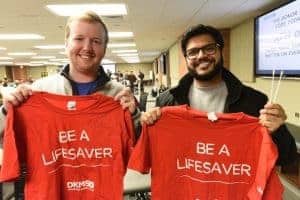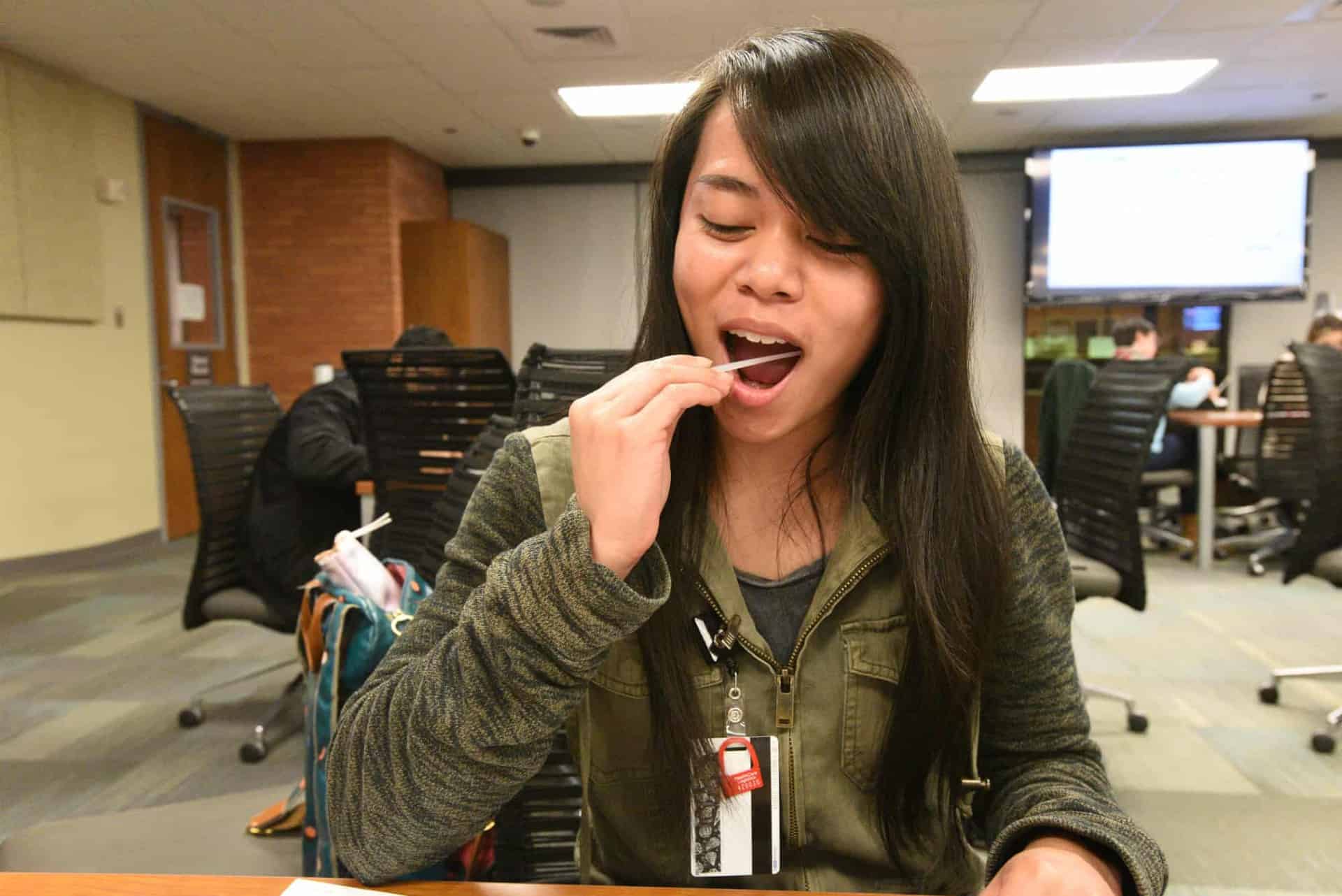Learn, Swab – and Maybe Save a Life: COM Students Join Bone Marrow Registry
| At the end of a recent team-based learning session on bone marrow failure, the entire freshman class of the College of Medicine at the University of Arkansas for Medical Sciences (UAMS) pulled swabs from sterile packets and collected their own saliva samples.
It could save someone’s life one day.
The class was participating in a bone marrow registry drive conducted by volunteers from the class above them. The tradition began last year, when then sophomores Bethany Verkamp and Ryan Steele organized a drive for their own class and then conducted a drive for that year’s freshmen during their hematology-oncology module.

Sophomore John Patterson spearheaded this year’s drive for freshmen during the Hematology-Oncology Module.
“We thought that a group of 174 eager medical students who had just learned how important bone marrow transplants are for patients with certain leukemias, lymphomas and other conditions would be a great group to ask to register,” Verkamp explained. “It was also a way that students could actively feel like they were helping the patients that they were learning about.”
With a goal of establishing a sustainable annual drive coordinated by the sophomores for the freshmen, they passed the baton for this year’s drive to sophomore John Patterson and volunteers from his class.
“This is a great way for medical students to help those who are in need of life-saving bone marrow transplants while simultaneously learning about the pathophysiology of diseases,” Patterson said. “My aunt had leukemia as a child and received a life-saving bone marrow donation. That was always interesting to me while growing up, but I didn’t fully understand the process until coming to medical school.”
“Donating bone marrow is similar in respect to donating other organs, in that an individual needing a transplant must be matched as closely as possible to a donor to avoid rejection,” Patterson explained. “This is done primarily through HLA (human leukocyte antigen) typing, with other factors such as ethnicity also taken into account. HLA markers are recognized by the immune system, so the more that the HLA matches between the donor and patient, the less likely the chance of rejection is.

Freshmen Paige Jones (left) and Katelyn Ragland complete paperwork for the bone marrow donor registry.
“While that may sound simple, it is actually quite difficult to find good matches for many people, with some patients dying before ever finding a match. However, unlike other organs, our bone marrow can be stimulated to grow, and it will return to its normal state after donations. This means the best way we can help is by getting registered and getting others to register.”
The College of Medicine drives were coordinated through DKMS, an international nonprofit bone marrow donor center affiliated with the National Marrow Donor Program, which operates “Be the Match,” the U.S. bone marrow donor registry.
If students had any doubt that they could make a difference by registering, two of their peers have proven otherwise.
Patterson relayed an uplifting testimonial from Matt Denefe, a junior who registered last year during the first drive at UAMS. Denefe has since matched and traveled to Tulsa, Oklahoma, to donate bone marrow for a 39-year-old woman with acute myeloid leukemia (AML).
Freshmen also heard directly from one of their own classmates, Chris Quesada, who had participated in a registry drive elsewhere four years ago. He received word last fall that he appeared to be a match for a patient. More testing followed, and just a few weeks before the recent UAMS drive, Quesada traveled to Tulsa to donate marrow for a 66-year-old woman with AML.

Freshmen Joshua Estes and Win Lubana hold up T-shirts conveying the ultimate goal of bone marrow registry drive participants.
“It was a really cool experience and I would highly suggest you guys register,” he told his class members. “It really could save someone’s life.”
Hematology-Oncology Module Director Jerry Ware, Ph.D., and Shelley Crary, M.D., an associate professor of pediatrics who teaches in the module, are more than happy to carve out time from the team-based learning session for the annual drive.
Crary told students about the importance of bone marrow transplants for benign hematologic conditions such as sickle cell disease in addition to leukemia and other malignancies. While sickle cell disease disproportionately affects certain ethnic groups including African-Americans, the national bone marrow donor registry has very small numbers of individuals from these groups.
Ware, a professor of physiology and biophysics, applauds students for initiating and participating in the drives. “I just think it speaks to the caliber of our students that they so willingly embrace helping others even before becoming clinicians,” he said.
Learn more about the National Bone Marrow Donor Program at BeTheMatch.org and about DKMS, the donor center that supported the COM drive, at DKMS.org.
